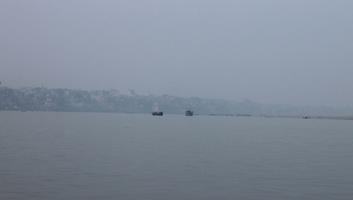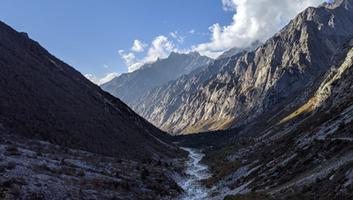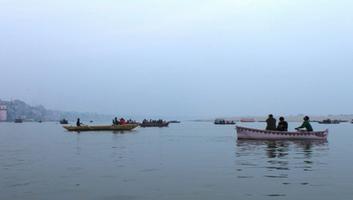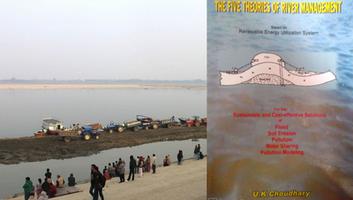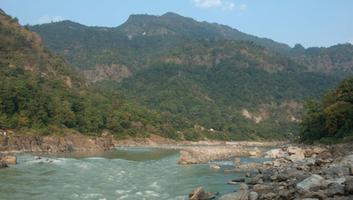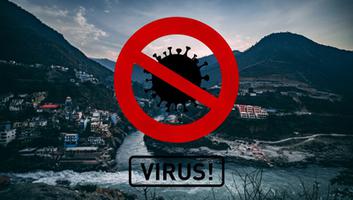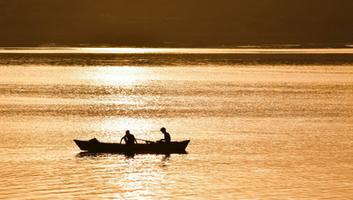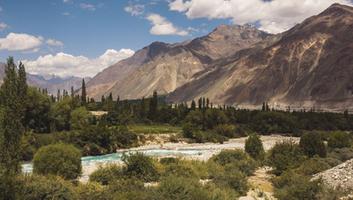Ganga River - Restoring River Ecology through Involvement of Women
- By
- Mukesh Shukla
- April-03-2019

Ganges is believed to be one of the most sacred rivers of India with its valuable ecological and economic significance. The 2,525 km river rises in the western Himalayas in the Indian state of Uttarakhand and flows south and east through the Gangetic Plain of North India. Due to greedy exploitation of river resource and increased population pressure and climate change phenomenon make Ganga to loseits pristineness. The majority of population lives in rural areas and their livelihood directly or indirectly depend on river water resource. Same time major cities in plains of Ganga e.g. Kanpur, Allahabad, Varanasi, Patna and Kolkota being located on bank of Ganga. Municipal sewage of these cities including catchments water carrying chemical and microbial contamination directly or through its major tributary rivers like Yamuna, Gomti, Ghaghra, Ramganga and Saryu and other uncontrolled man-made waste disposal into river stream is one of the main reasons of degradation of ecology of Ganges. Chemical farming practice along riverside is also harming river-life.
Women have significant role in the society to raise their children and educate them about social and moral values to become a responsible citizen. This is how women can play lead role in behaviour change of masses to create a river-friendly society.
Introduction
Ganges River, popular Hindi name is Ganga, a great river of the plains of the north India. It is a longest trans-boundary river of the Indian subcontinent which flows through the states of India and Bangladesh. The region is very culturally rich and famous for ‘Ganga JamuniTehjeeb’. Ganges river was declared National River of India in year 2009-10. Therefore it has very significant role in agricultural productivity, water security and ecological stability in the region. The major part of Ganga basin falls into Gangetic plains, one of the most culturally rich, highly cultivated and densely populated area in the world. Merely half of the population in plains consists of women and It has been the holy river in Hinduism and have great aesthetic value especially among women. Both urban and rural women have double roles in the society, productive as well as reproductive. Women are taking care of festivals linked with holy river, raising their children and teaching them ethical values towards mother nature, especially about river GANGA. An aware community will act as ‘Guard of Ganga’. This is to be given utmost importance to sensitize common people for positive behaviour change with respect to river and influence policy makers, administration to make and effectively implement the river friendly development initiatives. Rivers are our lifeline and river resources are important for economic development of the society and ecological balance in our natural environment. Ganges is home for variety of fresh water species native as well as migratory birds comes for breeding and feeding purpose during winters.

Today the Ganges river basin is the most populated river basin in the world. Average population density in the Ganga basin is 510 persons per square km as against 312 for the entire country (2001 census). Aside from providing drinking water and irrigating fields, the Ganges River is extremely important to Hindu population for religious reasons as well. It is worshipped as the goddess Ganga Ma or Mother Ganges. Despite the religious significance and daily importance of the Ganges river for the people of India, it is one of the most polluted rivers in the world. Pollution of the Ganges is caused by both human and industrial waste, Fecal coli-form bacteria levels near Varanasi are at least 3,000 times higher than the what is established by the World Health Organization as safe (Hammer,2007). Women are good resource manager in the society and they represent a kind form of Mother Nature. In Indian myth, rivers are alike women and this kind of sensitive belief makes a firm bonding between the two. On the river stretches of Ganges the women population can be categorized in to urban, semi-urban and rural women. Empowered group of urban women is able to create a river sensitive society through education, awareness and campaigns to influence the government, policy makers, and development actors to came forward and take positive actions to preserve river ecology. On other hand rural women are less empowered but they are found directly involved in natural resource management in terms of livelihood based on river resource. Rural women have especial sensitivity for the river but they need to be capacitated on wise use of river resource and also take part in community mobilization for awareness about river conservation. NGOs working for environmental conservation and green livelihoods promotion through natural resource management and conservation education will be the main partner for establishing the women based community institutions in the riverside villages, towns & cities etc. Moreover women shall play lead role in creating a river friendly society by educating their children and mobilizing family members to take part in river conservation initiatives and come forward as Guards of Ganga. This kind of community awareness drive in leaderships of women group and involvements of the CBOs, Educational Institutions, development actors and media will help in mass mobilization to preserve GANGA.
Cultural Significance of Ganges River
Every year millions of men and women take holy dip in Ganga. The religious importance of the Ganges may exceed that of any other river in the world. It has been revered from the earliest times and today is regarded as the holiest of rivers by Hindus. While places of Hindu pilgrimage, called tirthas, are located throughout the subcontinent, those that are situated on the Ganges have particular significance. Among those are the confluence of the Ganges and the Yamuna popular as Prayag, where a bathing festival, or mela, is held in January and February; during the ceremony hundreds of thousands of pilgrims immerse themselves in the river. Other holy places for immersion are at Varanasi and at Hardwar. The Hugli River at Kolkata also is regarded as holy. Other places of pilgrimage on the Ganges include Gangotri and the junction of the Alaknanda and Bhagirathi headstreams in the Himalayas. The Hindus cast the ashes of their dead into the river, believing that this gives the deceased direct passage to heaven, and cremation ghats (temples at the summit of riverside steps) for burning the dead have been built in many places on the banks of the Ganges. A large number of cities have been built on the Gangetic Plain.


Among the most notable are Saharanpur, Meerut, Agra (the city of the famous TajMahal mausoleum), Mathura (esteemed as the birthplace of the Hindu god Krishna), Aligarh, Kanpur, Bareilly, Lucknow, Allahabad, Varanasi (Benares or Kashi; the holy city of the Hindus), Patna, Bhagalpur, Rajshahi, Murshidabad, Kolkata, Haora (Howrah), Dhaka, Khulna, and Barisal. In the delta Kolkata and its satellite towns stretch for about 50 miles (80 km) along both banks of the Hugli, forming one of India’s most-important concentrations of population, commerce, and industry.
Rich Biodiversity of India
What is Biodiversity: Bio=life, Diversity= variety Biodiversity is variety among living forms. It can be mainly classified into 3 types; species diversity (number of plants and animals species), genetic diversity (variations in a same species due to different genes), Ecosystem diversity (forest, grassland, wetland etc.). India is very rich in biological diversity; it has 7% of world’s animal diversity and 11% of world’s plant diversity. India has 2% of world’s total land surface and 8% biodiversity. It has world’s wettest, driest region. India is one of the 17 mega diversity country in the world and 2 hotspot of biodiversity (Western Ghats & Eastern Himalaya). On the basis of rainfall pattern and topography India has ten bio-geographic regions are Trans-Himalaya and Himalaya, The Gangetic Plain, North East India, The Indian Desert and The Semi –arid Zone, Western Ghats, The Deccan Peninsula, The Coasts and Islands. Biodiversity has immense significance for human life; we get food, fiber, shelter everything from biodiversity. Life on earth planet is impossible in absence of biological diversity and water is key resource to sustain biodiversity (all life forms). Rivers are valuable gift of nature being main source of moving fresh water at distances being used for drinking, irrigation and development purposes. Today biodiversity degradation is accelerated due to increased human population pressure, unmanaged development projects, over exploitation of natural resources, deforestation, animal hunting and poaching, river pollution and exploitation, and climate change factors are major threats. We need to preserve the biological diversity to sustain the lives and livelihood by adopting river friendly lifestyle and sustainable development initiatives. Women are good resource managers and they can play an important role in river conservation by creating a river-friendly society.
The Gangetic Plains
Ganga is national river of India. Major rivers in Ganga river system are Ganga and its tributary Yamuna, Ram ganga, Gomti, Ghaghra, Gandak, Kosi and Son. Ganga is one of the most sacred river of India and considered as lifeline of millions. It is home for around 550 resident and migratory birds. The significant biodiversity of Ganges includes the Gangetic dolphin (Platanista gangetica), three species of otters viz. the Smooth-coated otter (Lutrogaleperspicillata), Eurasian otter (Lutralutra) and the Small clawed otter (Aonyxcinereus), the Critically Endangered Gharial (Gavialisgangeticus), Mugger or Indian marsh crocodile (Crocodyluspalustris), Estuarine crocodile (Crocodylusporosus) and at least 12 species of freshwater turtles, including the Critically Endangered Batagurkachuga. Within the Ganga River system, 143 different freshwater fish species, belonging to 11 orders, 32 families and 72 genera have been reported including the Critically Endangered Ganges shark (Glyphisgangeticus), Gangetic stingray (Himanturafluviatilis), Golden mahseer (Tor putitora) and Hilsa (Tenualosailisha)(Sinha1999).
The major part of Ganga basin falls into Gangetic Plains. It is one of the most cultivated and densely populated region in the world. It has more than one lakh wetlands and two Ramsar sites. Wetlands are important ecosystems, they store rain water and recharge ground water table and also control flood conditions as they act as sponge to hold water. More than 1 billion world’s population is dependent on wetlands directly or indirectly for their livelihood. (Nickson 2007). The 4 states in India represents gangetic plains are Uttar Pradesh, Bihar, West Bengal and Jharkhand. The total land surface is 3,54,848 km2 of which conserved area of the gangetic plains is 10.8 %. Some important conserved areas are Dudhwa National Park, National Chambal Sanctuary, Vikramshila Gangetic Dolphin Sanctuary. (Jones1982)
Gangetic Dolphin (Platinistagangetica)
Ganga river dolphin is a shying fresh water mammal. Dolphins are key stone specie in river ecosystem also health indicator of river. They are blind and find their path and catch prey in water through echolocation.

They
are slow swimmer but top predator in food chain as dolphins have a flexible
neck to catch their prey mainly minor fish, crabs, crustacean and
sometimes water birds. River Dolphins are important for river ecology and their
species is endangered due to river pollution, less water in river and declining
number of minor fish, motor boats, navigation operations and hunting. Locally
they are known as ‘Sons’ in UP and ‘Susu’ in Bihar state. In India the
estimated population of dolphin is between 1200-2000 surviving in Ganga and
Brmhaputra river system. Every 2-3 minutes they come to water surface for
breathing, dolphin breed once in a year and give birth to a single calf.
Gangetic dolphins one of four freshwater dolphins in the world, was declared India’s
National Aquatic Animal in 2009.(Sinha & Behera 2010). The species back from
brink. They need utmost importance of conservation. River Dolphin is the
National Aquatic Animal of India. The main reasons for decline in
population of the species are poaching and habitat degradation due to declining
flow, heavy siltation, construction of barrages causing physical barrier for
this migratory species. River dolphin is a endangered species in India and
therefore, has been included in the Schedule I for the Wildlife (Protection)
Act, 1972. Habitat conservation should be given utmost importance to protect
the dolphins has significance role in river ecology.(Behera 1995). Recent census data of WWF,
India shows slight increase in population of river dolphins 30-40 has recorded
in year 2018-19 at river stretch in Uttar Pradesh.
Turtles are natural Safaikarmi of river ecosystem, they feed on dead animals and decaying plants and cleans the river. There 15 species of fresh water turtles found in gangetic plains out of 25 total in India. Chambal River is tributary of Yamuna and home for 8 rare varieties of fresh water turtles including Red roofed crown turtles a critically endangered species. Turtles are important for river ecology and threatened due to poaching, illegal trading of turtles, damage to eggs, sand mining from river bed etc.
Gharials (Gavialisgangeticus) are largest (16 ft, to 22 ft.) fresh water crocodilian commonly known as fish eating crocodile. They has beak like elongated mouth and mainly prey upon fish, birds and crabs. Gharial live in deep fast flowing river water, they come to surface for breathing and lays eggs on sand of river bank. They do basking. Gharials do not harm humans and large animals. Gharials are critically endangered in IUCN’s red data book as there population is gradually declining due to hunting for skin, habitat loss, less fish in the river, damage to eggs due to sand mining and being eaten by predator birds. Gharials also died due to suffocation as they get entangled in fishing nets.(IUCN1996) They are endemic to India as the specie not found anywhere else outside. There are two breeding centres of gharials in Kartaniaghat wildlife sanctuary and national Chambal sanctuary in Uttar Pradesh. They are key stone specie and protect the river. Government is giving utmost importance of conservation of the specie as there are less than 300 gharials are left surviving in India. (Haque 1997).

Findings: Ganges river biodiversity conservation, threats and corrective measures to restore the ecology of lifeline of millions in North India
Ganges is facing threat of extinction because of human population pressure, pollution caused by uncontrolled industrialization and tannery effluents, discharge of untreated sewage, unsound agricultural practices, over fishing and exploitation of river resource.
“Everybody says women are like water. I think it's because water is the source of life, and it adapts itself to its environment. Like women, water also gives of itself wherever it goes to nurture life....” ― Xinran, The Good Women of China.
Life is not possible without water, that much is an irrefutable fact. Water is essential for plants and animals and integral to sustain life on earth planet. On Earth, about 71% of the planet’s surface is covered with water. The oceans hold over 96% of all Earth’s water, while the vast majority of freshwater resources is locked up in ice caps, glaciers and underground storage. Only around 1% of total water in our planet is in usable liquid form, mostly in rivers, streams and lakes. Rivers are our lifeline, sustaining the lives and livelihood of millions. Increasing population pressure, over exploitation of river resource, and retreating of glaciers due to global warming are major threats to Ganga.
The longest river (2500 km) of India is flowing from Goumukh in Uttarakhand to the Bay of Bengal at Ganga Sagar in West Bengal, covering 26% of India’s landmass, And Ganges is on verge of extinction as, it has become one of the most polluted river in the world. The plains of Ganga are one of the highly cultivated and densely populated regions in the world. We need to design better strategies, that apply scientific knowledge to restore and preserve important freshwater ecosystem. People has become so greedy and lost sense of respect for the river. Ganga is also home for important animals like Gangetic dolphins, Smooth-coated otter, gharials, turtles, fresh water fish and bird species.(Yeung 2009).
These animals are important for river ecosystem, now the days they’ve became endangered due to river pollution, hunting and habitat loss. The river life is under serious threat and number of important flora and fauna is declining fast including key stone specie gangetic dolphins along with other reptiles, fish, birds and mammals. Gangetic dolphins are river health indicators, top in food chain and designated as national aquatic animal of India. Dolphins are endangered in IUCN's red data book. (IUCN2001). Gangetic dolphins are river health indicators, top in food chain and designated as national aquatic animal of India. The purpose of this social research project is to address the reasons of loss of biodiversity in river Ganges and encourage people's involvement in conservation. There’s need to give utmost importance of conservation of river life to restore the ecology of Ganga.
The major threats to Ganga are discharge of municipal sewage, human made waste disposal and untreated industrial and tannery effluents into river flow, construction of dams and barrages, overexploitation of river, unsound farming practices on riverside, deforestation, scarcity of water and reduced river flow due to diversions. In our society, women’s role is important in performing the religious rituals and same in case of Ganga being one of the most sacred river of India.
Women can play important role in mass awareness to create a sensitive society in rural areas as well as urban habitation. The purpose of this social research project is to encourage women’s involvement in river conservation as they can play lead role to preserve ecology of the Ganga. How to turn women as river conservationist? Women are good resource manager and they are closely linked with mother nature. Ganga has its priceless ecological and economic significance and sustaining the lives of millions in Gangetic plains. As it’s spiritual importance being described in Vedas, Ganga is called as MOTHER GANGA with its image of divine woman. The majority of population especially women consider Ganga auspicious and worship it various ways by performing religious rituals. This is how majority of population of riverside women is strongly linked with ecology, culture and spirituality. Their role is crucial to protect Ganges being source of lives and livelihoods of millions. In order to create a aware society sensitive for conservation of Ganges, there’s need to educate women about ecological significance of Ganga in rural as well as urban areas by creating “Women Community Institutions” awareness campaigns, sensitization of riverside community especially women group being lead players of water governance and natural resource management.


Women play productive as well as reproductive role in the society. They can be proved a good change maker, It is necessary to educate women mainly in the rural areas where they act as resource manager and create women’s community institution to link them with green livelihoods in order to minimize the pressure on river resource (Project Proposal,2007).It is equally important to conduct awareness campaigns in the cities located on the river bank. As women are the key person in family and in society at large to perform religious rituals on the ghats of Ganga, They can be easily get involved to save the important river of sacred belief of the largest population in India. An aware community must lead policy makers and administration to regulate the law for river conservation and check the municipal waste and industrial effluents in to the Ganges river.(Sinha & Prasad 2012).Women group will be engaged through community institutions build locally and they can help in mobilization of students, youth and people of all age groups for conservation of Ganga.
Involvement of Rural Women in River Conservation
Women are alike river and especially riverside women community are living their life with Ganges River in very close connection. Rural women are directly involved in river resource management for the livelihood related works and water governance. Others are connected with respect to aesthetic value and consider it auspicious Ma Ganga. Women are good resource manager and rural women group in the Gangetic plains includes students, farmers, housewives, livestock rearing and fishing community.
Farmers group of women rely upon river resource for irrigation, pillage on river bed during summers and winters seasons, as the agricultural land along with the river stretch is very fertile and productive in terms of crop yields farmer women are in daily contacts with Ganges River. Many are regularly visiting to riverside for livestock river rearing and collecting grass for cattle and fishing practice. Wetlands alongside of Ganges are very productive in terms water security and livelihoods and most of these wetlands are managed by rural women for many purposes. It is very proven fact that village women group are directly or indirectly in close contacts with Ganges river and they can act as river conservationists after attending mobilization programme related to conservation of Ganga. Locally formed village level women community institutions will play lead role in uniting community, spread awareness, educate children and sensitize common people about significance of Ganges River for human life and importance of its protection.
In order to engage rural women in river conservation, there’s need to create their own institution locally to educate them about significance of river life for humans and their role to preserve the river of spiritual as well as economic value.

“Women Community Institution” in the rural areas will be capacitated on green livelihoods options and their role to educate family members and villagers about significance of river conservation by adopting river-friendly lifestyle, sustainable farming practices, wise use of river resource to get continued blessings of Vedic river ( UNEP 2010). The aforesaid women community institutions shall be created by involving local NGOs, CBOs, Youth Volunteers and Public Private Sector. The women farmers and their family members will be engaged in organic farming practices, waste management & good sanitation, compost making, plantation of large trees and fruit trees, pond management and water governance to minimize pressure on river resource and capacitated on sustainable livelihood practices. This kind of educational and training programme on sustainable use of river resource through involvement of development agencies and local institutions shall turn the rural women as river conservationist and help in establishing river friendly rural environment.
Involvement of Urban Women Community in Conservation of GANGA
The urban women community has diverse groups of working and non-working, students and other professionals. To involve urban women group as Leaders for river conservation we need a definite strategy to unite them and build ‘urban women community institution’ with respect to social profiles with the help of active women volunteers, NGOs and also engage public-private sector partners to conduct education programmes on river conservation at work places of corporate and government administration. An aware woman can easily influence their immediate family and society at large (Wongchachom C. (2006). Thus, urban women shall also act as Guard of Ganga through education, awareness and establishing women clubs, forums in-between working group and professionals, housewives and students (Cros 2002). Urban women group will take part in community awareness about promotion of local biodiversity, consumption organic agriculture produce, stop using things of made up of leather to discourage tanneries on river banks, stop throwing waste into river and keep Ghats of Ganga clean. These activists group of women shall educate their children and also sensitize their family members to live a river friendly lifestyle and raise voice for Conservation of Ganga. This cascade of awareness drive shall help in mass mobilization and same time influence policy makers and government to act for conservation of National River of India.

Conclusion
Ganges is sustaining lives and livelihood of over 500 million citizens in India. There is need to spread awareness to create a river-friendly sensitive society and bring serious attention of policy makers to check the pollution and preserve Ganges river. Although river conservation is an issue that disproportionately impacts women, we cannot reach the goal of preserving water resources unless we all get involved in educating ourselves about threats to river resource and supporting the empowerment of women through education and equality of opportunities. Sensitization of women group to address the river conservation issues and its significance for sustainability of life can play important role to restore the ecology of Ganga. There is need of social awareness and serious attention of policy makers to check the river pollution, promote afforestration, sustainable agriculture practices and welfare oriented programs to empower riverside community with a focus on women (WCED Report, 1987).
Conservation education and community awareness can play important role to preserve the biodiversity. Most importantly there must be an effective sensitization program among villagers and farmers community especially women group regarding sustainable management of natural resources, adopt smart and scientific agricultural practices for improved yield and increased income. Villager's mobilization and training on sustainable livelihood solutions, insure a wise use of fish resource and live a river friendly lifestyle, encourage them to take part in nature conservation by adopting eco-friendly lifestyle. It will help to preserve the natural environment if farmers can adopt natural farming practice and common citizens minimize the ecological footprint by promoting local biodiversity.
References:
Sinha, R. K. 1999. The Ganges River dolphin
tool for baseline assessment of biological diversity in River Ganges, India.
Final. Technical Report No. 1/99. Patna University, Patna, India.
United Nations Environment Program (UNEP)
(2010). Green Economy Developing Countries
Success Stories, UNEP, Geneva.
Sinha, R.K., and K. Prasad. 2012. Management
of water quality and biodiversity of the River Ganga. In Ecosystem &
integrated water resources management in South Asia, ed. E.R.N. Gunawardane, B.
Gopal, H. Kotagama, 104–132 pp. London, UK: Routeledge, Taylor and Francis
Group.
Jones, S. 1982. The present status of the
Gangetic susu, Platanista gangetica (Roxburgh), with comments on the Indus
susu, Platanista minor Owen. FAO Advisory Committee on Marine
Resources Research Working Party on Marine
Mammals. FAOFish. Ser. (5) 4: 97–115.
IUCN. 2001. IUCN Red List categories and
criteria: version 3.1. IUCN Species Survival Commission. IUCN Gland,
Switzerland and Cambridge, UK.
IUCN. 1996. 1996 IUCN Red List of threatened
animals. IUCN, Gland, Switzerland and Cambridge, UK. 448 pp.
Haque, A.K.M.A., M. Nishiwaki, T. Kasuya, and
T. Tobayama. 1997. Observations on the behaviour and other biological aspects
of Jr., Z. Kaiya, and L. Jiankang, Vol. 3. Gland, Switzerland: IUCN.
Nickson, R., C. Sengupta, P. Mitra, S.N.
Dave, A.K. Banerjee, A. Bhattacharya, S. Basu, N. Kakoti, N.S. Moorthy, M.
Wasuja, M. Kumar, D.S. Mishra, A. Ghosh, D.P. Vaish, A.K. Srivastava, R.M.
Tripathi, S.N. Singh, R. Prasad, S. Bhattacharya, and P. Deverill. 2007.
Current knowledge on the distribution of arsenic in groundwater in five states
of India. Journal of Environmental Science and Health—Part A 42: 1707–1718.
Sinha, R.K., S.K. Behera, and B.C Choudhury.
2010b. Conservation Action Plan for the Gangetic dolphins. National Ganga River
Basin Authority, Ministry of Environment and Forests, Govt of India. pp 44.
Yeung, L.W.Y., N. Yamashita, S. Taniyasu,
K.S. Lam, R.K. Sinha, D.V. Borole, and K. Kannan. 2009. A survey of
perfluorinated compounds in surface water and biota including dolphins from the Ganges River and in
other water bodies in India. Chemosphere76: 55–62.
WCED Report (1987) Our common future. World
Commission on Environment and Development, Oxford University Press.
Cross, J. and Wuthisen S. (2002)
International Higher Education Collaboration for Staff Research.
Development: A Case Study in Thailand,
Proceedings of the EDU-COM 2002 International
Conference, Edith Cowan University pp124-132.
Project Proposal (2007) A water resource
development project in a sustainable agriculture system. Limited Circulation,
Phayao, Thailand.
Wongchachom C. (2006) An investigation into a community information database system in the northeast of Thailand: community empowerment through community learning centres. Doctoral Dissertation. Edith Cowan University.


